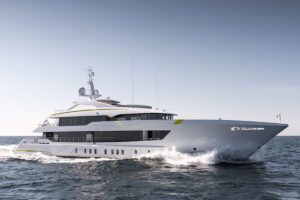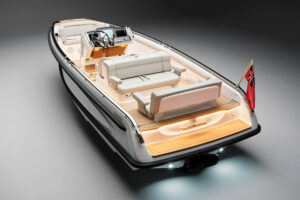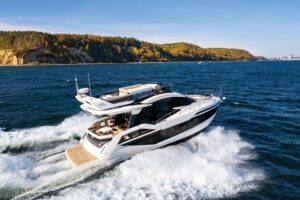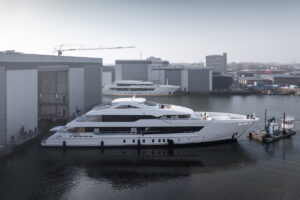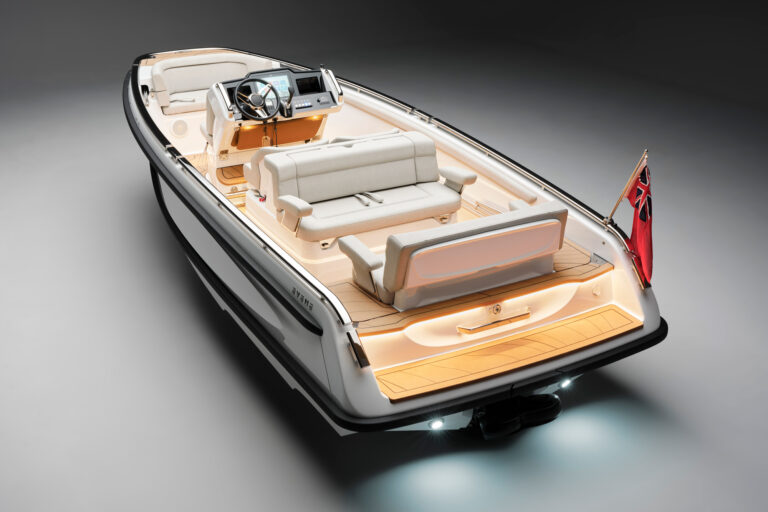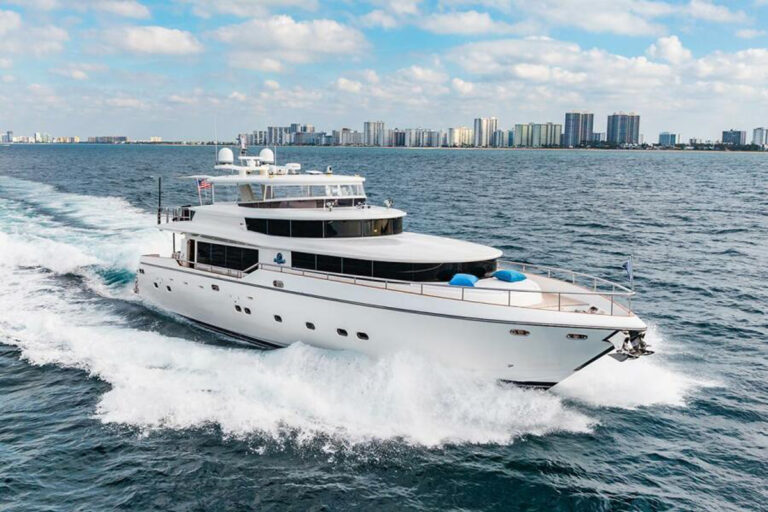The new Hatteras 75 Cockpit Motoryacht is an emotional rescue for yacht owners who are not smitten by the seductive sheers and curves of European boats. For too long, I felt American-built motoryachts were forced to trade speed and handling for plush accommodations, livability and creature features. That observation changed abruptly when I took the helm in the ocean off Ft. Lauderdale and had a saltwater epiphany. With a pair of 1,400 hp 3412E Caterpillars ramped up to 2325 rpm, this 56 ton beast ripped to a top speed of 27 knots, ignoring the 3′ to 4′ seas as though it were stepping on grapes. This is the only new current Hatteras motoryacht without propeller pockets, so she runs level even when the trim tabs are up. In a head sea this accounts for some spray on the windshield, particularly at full speed if you happen to punch through a green one, because she doesn’t move around much or pound. She runs through everything like a fullback. The swishing of spray whiting out the windshield filtered engine chatter to barely audible levels. Even as the wipers cleared the glass between deluges, the decibel meter never passed 74. Power hydraulic steering was flats-boat quick. On full-tilt turns, four revolutions lock-to-lock, she wheeled around like a sportfisherman whose skipper just got the word the sailfish were biting 10 miles away on a reciprocal heading with only an hour to go in the tournament.
In calm waters, and around busy Bahia Mar, the big Hatteras was oblivious to beam winds, thanks to her 6-foot draft. Yet, when I engaged one or both transmissions, she awoke like a sleeping retriever that heard the refrigerator door slam. Six-blade 48- by 76-inch propellers turn on 3 1/2-inch shafts. With a massive .87 blade ratio and 4.36:1 gear ratio, these propellers move water like opening up Hoover Dam flood gates. Conversely, pulling back on the throttles was the closest thing to a boat with brakes I’ve experienced in some time. Stabilizers are standard and a 28 hp bow thruster is an option.
Ordinarily, a boat of this LOA mandates a full or partial crew. While her size will necessitate regular elbow grease to keep the snow-white polyurethane painted exterior clean, the windows spotless and the stainless-steel polished, a husband and wife team should be able to run this boat themselves without breaking a sweat. Not only is the boat responsive, but the helms and deck plans facilitate short-handed operation.
Springline cleats are conveniently placed right outside the port and starboard wheelhouse doors, which also access the foredeck. With her good manners, it would be easy to lasso a piling, warp the line around the spring cleat and feed slack to it while you’re standing at the lower helm working the clutches to jockey the boat into place. The rear bulkhead is sliding glass that is framed in polished stainless steel for an unobstructed view astern. Aboard many motoryachts, you hope there’s enough stern visibility to keep a piling in sight to help judge your position backing down into a slip to prevent ripping off the swim platform. Aboard this boat, looking aft is like viewing a movie screen in a theater. This feature also proved useful during the sea trial when a 20 knot gust of north wind blew the bow cushion overboard and we backed up to retrieve it. I had some concern that the sliding glass might compromise the after bulkhead, or cause the roof to wobble in a seaway. But Hatteras informs me that the frame is bedded into six-inch thick fiberglass and the hardtop is not freestanding.
Docking from the flying bridge station won’t be a problem, either. The bridge wings are four feet wider than those on the Hatteras 74, the model replaced by this new boat. That’s two more feet per side, which is a significant advantage when pulling into a tight slip since you get a much better view.
Whether you run this boat from the lower helm to stay in the climate-controlled wheelhouse, or drink in fresh air from the bridge, you won’t be lonely. The lower helm has a lounge for three built over a chest of drawers. It’s comfortable, although I would add a footrest to support dangling feet. The flying bridge, available in two styles with an island or key bar and facing L-shape lounges, accommodates 20 of your friends, as well as a tender and water toys.
Like the flying bridge, the saloon makes maximum use of the wide-body design for dining and entertaining. Interior flow and furnishings aboard our test boat were specified by the owner, and they feature a table, sofas, occasional chairs and dual entertainment centers. Joinery was clear and birds-eye maple, with bullnose moldings against marble countertops and a beige color scheme. Frameless side windows wrap around the saloon and wheelhouse, admitting natural light while adding subtle shaping to her traditional yet modern profile.
Hatteras builds the 75 Series in multiple versions, and this bread and butter boat presently is on a 22-day schedule. Styles include the widebody cockpit version as tested, and walkaround side decks are optional. However, there’s enough walking surface and a sturdy cabin grabrail on this wide-body model to get my vote. I would prefer not to sacrifice interior acreage, since there is also the afterdeck and cockpit to enjoy. A Sportdeck model eliminates the cockpit in favor of a larger afterdeck. The test boat had five staterooms; the fifth cabin also can be an office. A four stateroom plan places three of the cabins forward of the engineroom, with the full-beam master suite and his and her heads aft.
The walkabout engineroom is a benchmark of engineering that a professional skipper and the owner/operator can appreciate. Virtually every piece of equipment and every through-hull fitting is labeled for easy identification and purpose. Throughout the yacht, hatches are cut into the sole to allow access and maintenance of crucial systems. Despite her beauty, she remains business-like. Portable fire extinguishers are sprinkled throughout the interior, either exposed in recessed compartments or stowed in well-marked lockers. A separate machinery room, forward of the amidships full-beam guest suite, houses a pair of generators and the air conditioning units. Installations are neat, clean and intelligently laid out.
Convenience is the mind set throughout the yacht. The standard electronics package includes a plotter, GPS, autopilot, VHF and depth and speed instruments. From simplified line handling to intuitively reaching for a light switch and finding it there in the dark, the Hatteras 75 makes a convincing argument that you don’t need to sacrifice accommodations or performance in an American engineered and built cockpit motoryacht.
Contact: Hatteras Yachts, (252) 633-3101; www.hatterasyachts.com.

